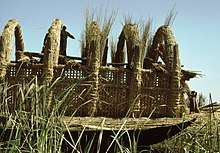Reed (plant)
Reed is a common name for several tall, grass-like plants of wetlands.
Varieties
They are all members of the order Poales (in the modern, expanded circumscription), and include:
In the grass family, Poaceae
- Common reed (Phragmites australis), the original species named reed
- Giant reed (Arundo donax), used for making reeds for musical instruments
- Burma reed (Neyraudia reynaudiana)
- Reed canary-grass (Phalaris arundinacea)
- Reed sweet-grass (Glyceria maxima)
- Small-reed (Calamagrostis species)
In the sedge family, Cyperaceae
- Paper reed or papyrus (Cyperus papyrus), the source of the Ancient Egyptian writing material, also used for making boats
In the family Typhaceae
- Bur-reed (Sparganium species)
- Reed-mace (Typha species), also called bulrush or cattail
In the family Restionaceae
- Cape thatching reed (Elegia tectorum), a restio originating from the South-western Cape, South Africa.
- Thatching reed (Thamnochortus insignis), another restio species originating from the same geographic region.
Use in construction


Many different cultures have used reeds in construction of buildings of various types for at least thousands of years. One contemporary example is the Marsh Arabs.
Thatching
Phragmites australis, the common reed, is used in many areas for thatching roofs. In the United Kingdom, common reed used for this purpose is known as "Norfolk reed" or "water reed". However, "wheat reed" and "Devon reed" are not reeds but long-stemmed wheat straw.
Use in music
Ancient Greeks used Arundo donax to make flutes known as kalamavlos; this is a compound word, from kalamos (cane) + avlos (flute). At the time, the best cane for flutes came from the banks of river Kephissos, in Attica, Greece. Several kalamavlos tuned differently and tied together, made a syrinx or Panpipes. A. donax is still the principal source material of reed makers for clarinets, saxophones, oboes, bassoons, bagpipes, and other woodwind instruments.[1] The Var country in southern France contains the best-known supply of instrument reeds.
Other uses
Bamboo and, even more commonly, rattan stems are used as "reed sticks" to wick and disperse the scent of essential oils in aroma diffusers. (See Rattan § Food source and medicinal potential.)
See also
- Bamboo
- Constructed wetland
- Rattan
- Reed bed
- Reed boat
- Reed fields
- Reed level
References
- Opperman, Kalman (1956). Handbook for making and Adjusting Single Reeds. New York, New York: Chappell & Co. p. 40.
External links
| Wikisource has the text of the 1911 Encyclopædia Britannica article Reed. |
| Wikiquote has quotations related to: Reed (plant) |
| Wikimedia Commons has media related to Reed (plant). |
